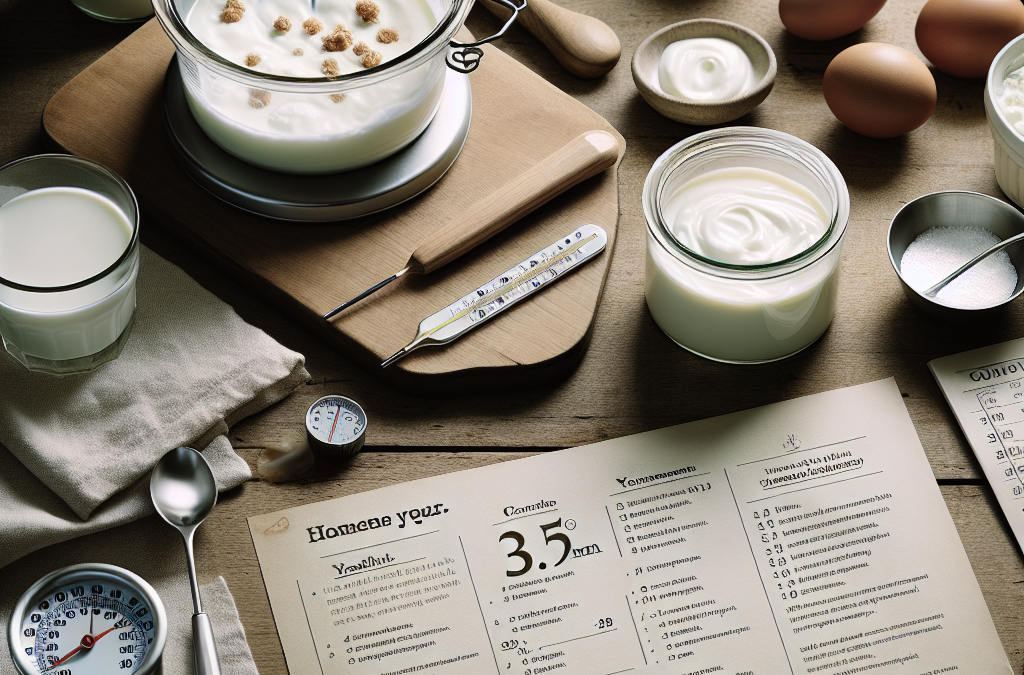Gather Your Ingredients
Choosing the Right Milk
When it comes to making yogurt, the choice of milk is crucial. Personally, I love using whole milk because it gives the yogurt a creamy texture that’s just unbeatable. But honestly, you can go with skim milk or even non-dairy alternatives if you prefer. Just keep in mind that the fat content can affect the taste and thickness.
Some folks swear by organic milk, and I totally get that! It tastes fresher and might even have better health benefits. But at the end of the day, use what you have on hand. The goal is to make some delicious yogurt, right?
Make sure the milk you’re using hasn’t been ultra-pasteurized, as this process can kill off the natural proteins we’re relying on for fermentation. So, check your labels and get ready for a yogurt-making adventure!
Buying the Right Yogurt Starter
Your choice of yogurt starter can set the stage for how your homemade yogurt will taste. I usually grab a plain, live-culture yogurt from the store—nothing fancy, but it should say “contains live cultures” on the label. This is where all the magic happens!
If you’re feeling adventurous, some people make their own starter by reserving a bit of their last batch of yogurt. Pro tip: Just make sure to refresh your starter every few batches to keep things lively!
Another option is to use powdered yogurt starter cultures available online or at health food stores. These are super convenient and ensure consistent results, especially if you’re just starting out.
Additional Flavorings and Sweeteners
Now, if you’re like me and enjoy a bit of flair in your yogurt, don’t forget to think about flavor! You can mix things in later, but I like to have some honey, vanilla extract, or fresh fruit on standby.
You can get creative too! Think about adding lemon juice for tang, or using spices like cinnamon for a cozy twist. Just remember that the flavorings will be mixed in after the yogurt has set, as you want the fermentation process to remain undisturbed.
Don’t go overboard, though. A little something special will do, and you can always adjust the sweetness and flavors after your yogurt is finished. Keeping your taste buds happy is key!
Prepare and Heat the Milk
Heating the Milk
Alright, it’s time to get things cooking! Start by pouring your milk into a heavy-bottomed saucepan and slowly heat it on the stove. I usually aim for just below boiling—around 180°F (82°C). This helps to kill off any unwanted bacteria and creates a nice environment for the good stuff to thrive.
Keep stirring occasionally to prevent scorching and maintain even heat distribution. Trust me, you don’t want burnt milk—it’s an absolute bummer. And if you have a food thermometer, now’s the time to put it to good use!
Once your milk reaches the right temperature, it’s time to remove it from the heat and let it cool down to around 110°F (43°C). Patience is key here, short cuts can lead to unexpected results.
Mixing in the Starter Culture
Once your milk has cooled to the right temperature, grab that yogurt starter you selected earlier. If you’re using store-bought yogurt, just whisk in about 2 tablespoons of that creamy goodness into a small bowl with some of the cooled milk first. This helps to blend it smoothly before adding it back into the whole batch of milk.
Once combined, gently stir it back into the saucepan. Make sure to do it carefully, as you don’t want to introduce too much air. The idea is to keep things nice and cozy for the cultures to do their thing!
After that, pour the mixture into your yogurt container or jars, cover them up, and get ready for the next step. A little love goes a long way here!
Maintaining the Perfect Temperature
This is where things get exciting! To turn that milk into yogurt, it needs to sit in a warm environment for several hours. I usually opt for an insulated cooler or simply wrap the jars in towels to keep them snug. There’s nothing complicated about it, but making sure it stays at a stable temperature—ideally around 100°F (38°C)—is super important.
Some people get fancy with yogurt makers or use their ovens on a low setting, and honestly, if that works for you, go for it! The live cultures need warmth to thrive and turn that milk into a creamy delight, so just find a spot that stays consistently warm.
Check on it after about 6-8 hours, and if it’s not thick enough for your liking, let it go a bit longer. The best part? You can give it a little taste test along the way!
Chill and Store the Yogurt
Checking the Yogurt’s Consistency
Once your yogurt has set and thickened up, it’s time to check it out. If it’s firm to your liking, congratulations! You’ve just made yogurt! If it’s still a bit runny, don’t worry; it often thickens more in the fridge.
The taste will also develop a bit more as it cools down. So, give it a little taste—this is perhaps one of the most rewarding parts of the whole process!
Remember, homemade yogurt won’t be as thick as store-bought varieties since a lot of those have thickeners and stabilizers. But trust me, the flavor is going to blow your mind!
Cooling Down
After you’ve given it a taste test and it’s perfect, pop it in the fridge—this will help it firm up even more. I generally let it chill for at least a few hours, though you can leave it overnight for best results.
Store it in clean, airtight jars. One of my favorite tricks is to save my empty yogurt containers to reuse, but just make sure they’re clean! You’ve put in so much effort; let’s make sure it stays fresh and delicious.
Just a heads up, homemade yogurt can typically last about 1 to 2 weeks in the fridge. But you’ll probably finish it long before that, trust me!
Serving Suggestions
Now that you’ve got your batch of homemade yogurt, how do you want to enjoy it? I love adding fresh fruits and a drizzle of honey to the top for breakfast, but there are countless ways to dive in! Try mixing in granola, making smoothies, or using it as a base for salad dressings and marinades.
The options are endless! Plus, it’s super fun to keep experimenting with new flavors and toppings each time you make a new batch.
Remember, it’s all about making it your own. Enjoy every bite of your delicious creation!
FAQ
1. Can I use any kind of milk to make yogurt?
Yes, you can use any kind of milk! Whole milk gives you creamier yogurt, but you can opt for skim milk or non-dairy options too. Just remember that the fat content will affect the texture.
2. How long does homemade yogurt last in the refrigerator?
Homemade yogurt typically lasts about 1 to 2 weeks in the fridge if stored properly. You’ll want to keep it in an airtight container to maintain freshness!
3. How do I know when my yogurt is done cooking?
Your yogurt is ready when it has thickened to your desired consistency and has a slightly tangy flavor. It usually takes around 6-8 hours but checking after 6 hours is a good way to start.
4. Can I add flavors to my yogurt before it sets?
It’s best to hold off on adding flavors and sweeteners until after your yogurt has set. This ensures proper fermentation without interference from other ingredients.
5. What if my yogurt doesn’t thicken?
If your yogurt doesn’t thicken, it might be due to a few factors like the temperature or the starter culture. Don’t throw it out—let it sit longer, or consider using a fresh starter next time!





